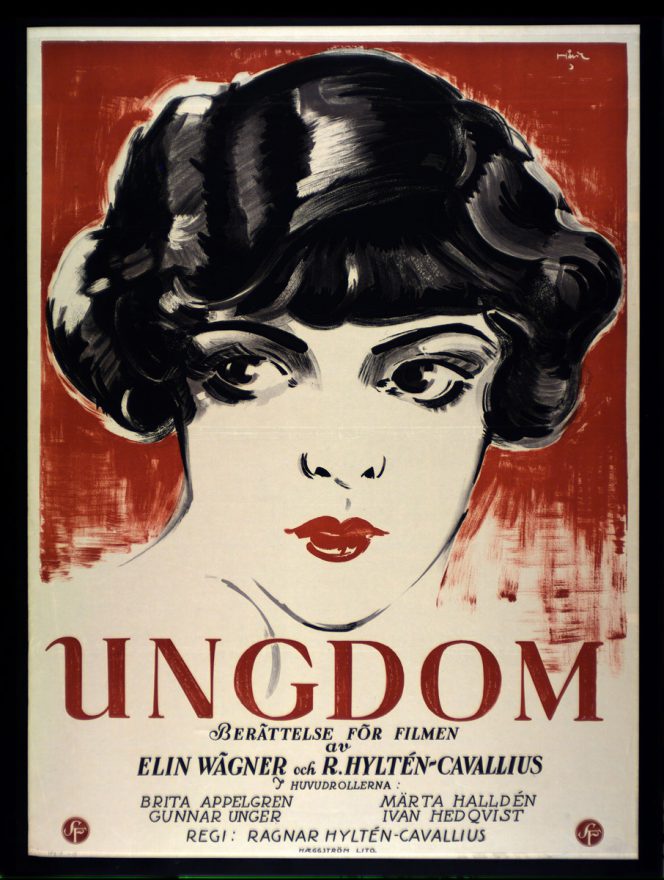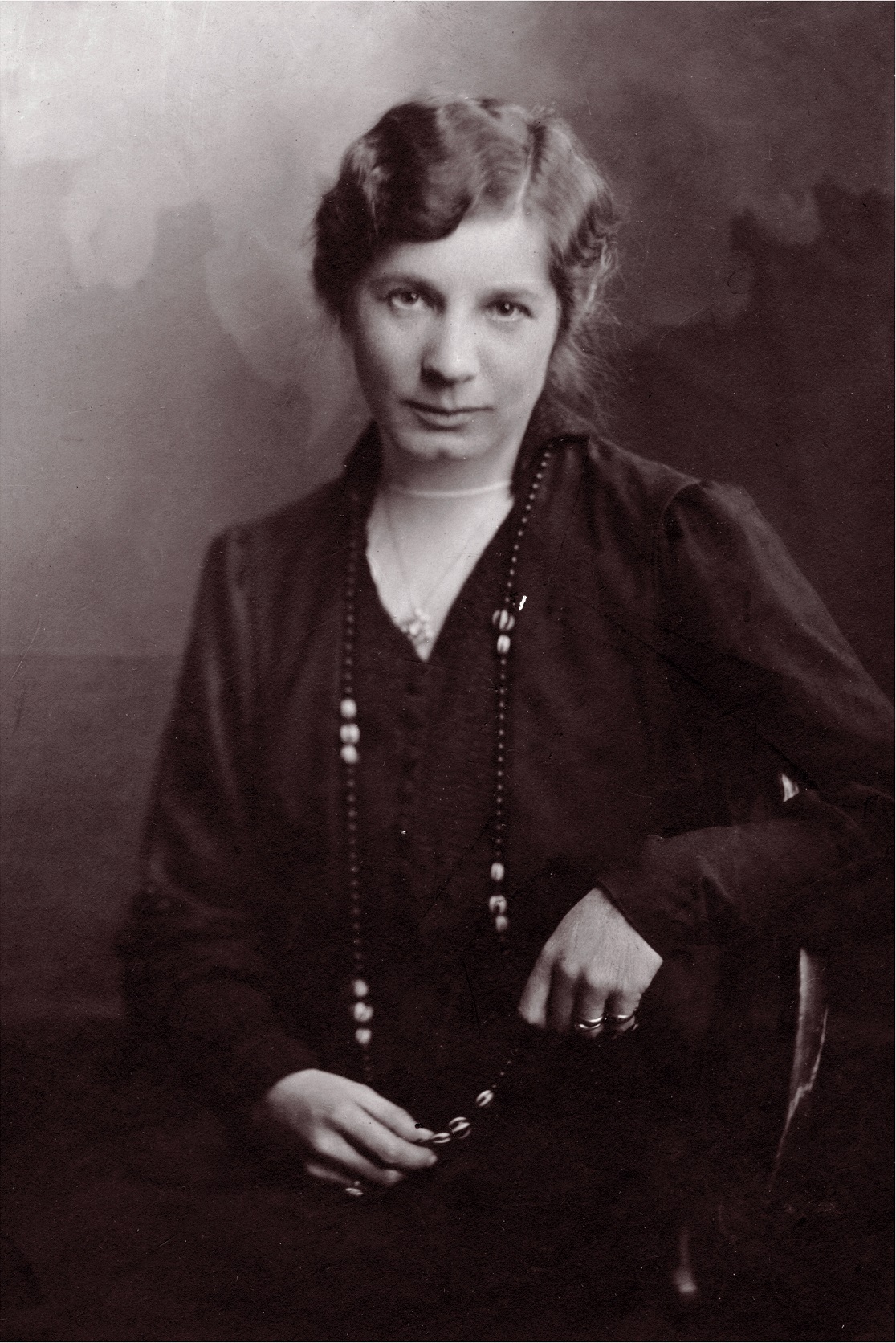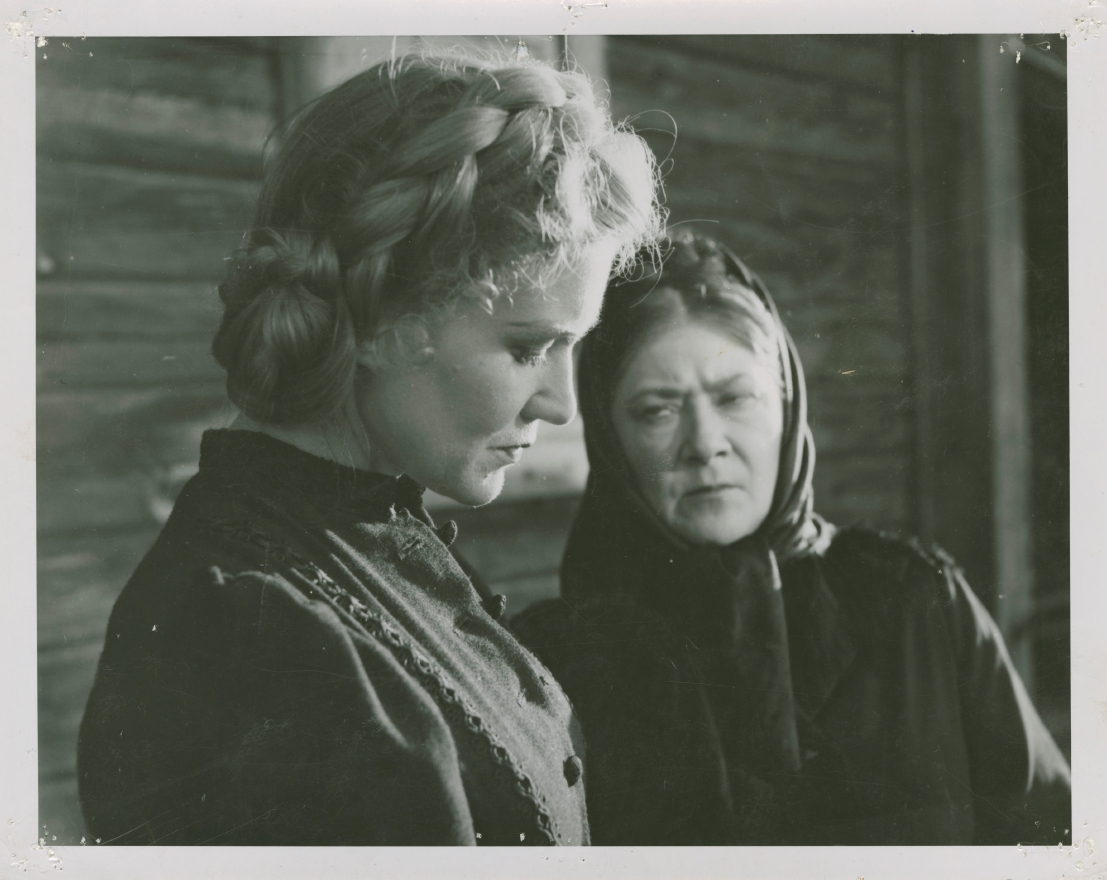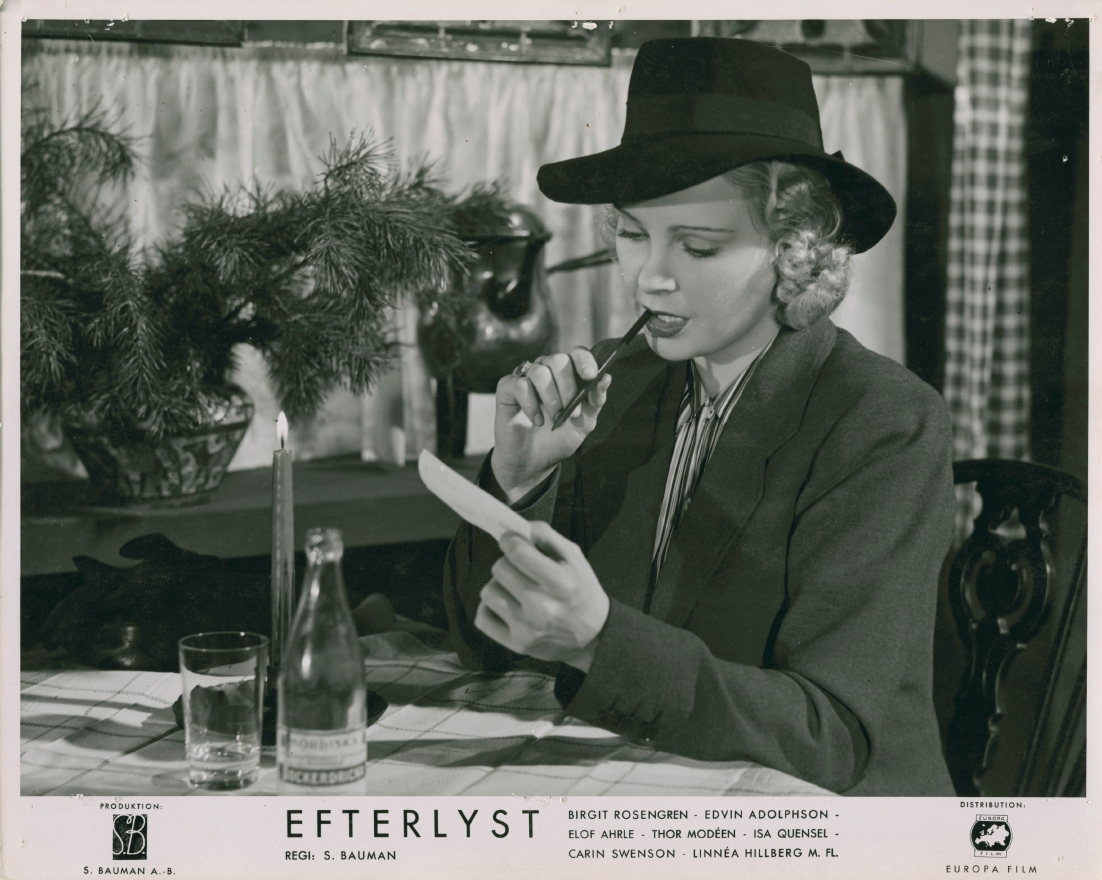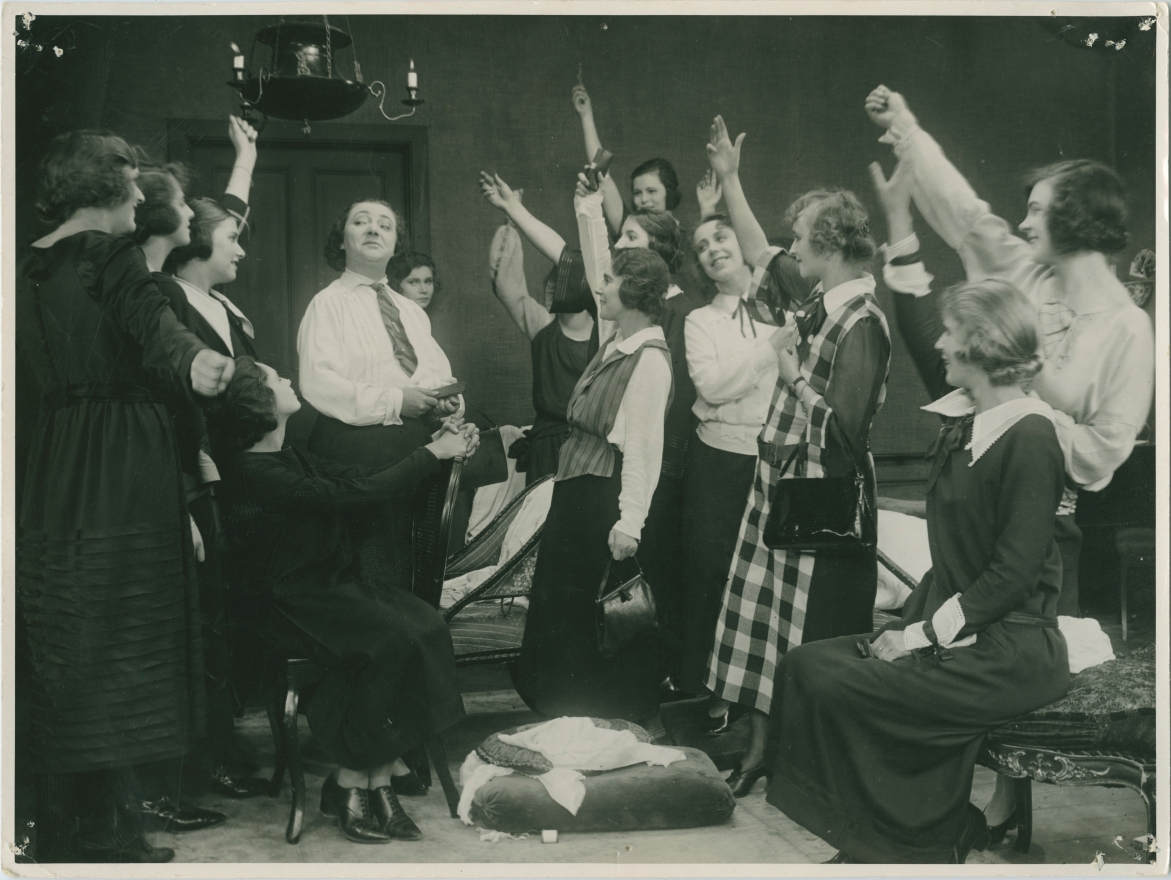Elin Wägner was a feminist, pacifist and ecocritic. She co-founded The Fogelstad Citizen School for Women and became the second woman after Selma Lagerlöf to be elected into the Swedish Academy in 1944. Elin Wägner is known for her activism for female suffrage, for her peace and environmental activism, for novels such as “Norrtullsligan” (“Men and Other Misfortunes”), “Pennskaftet” (“The Penholder”), “Åsa-Hanna” and the debate book “Väckarklockan” (“The Alarm Clock”). Her literary works have been explored from many different perspectives. Less examined, however, is her relationship with cinema, and Elin Wägner’s work for the film industry is rarely mentioned in the existing research, which mostly takes place within literary studies.
Elin Wägner, screenwriter
Wägner got her first hands-on contact with the film industry as early as 1911, the year after her novel “Pennskaftet” was published. Her first film assignment was to write the script for Hon fick platsen eller Exkonung Manuel i Stockholm (“She Got the Position or Ex-King Manuel in Stockholm”, 1911), a film made with the aim of establishing a travel scholarship fund for female journalists [1]. Elin Wägner herself plays a “penholder” and other female journalists, including Ellen Landquist, starred in the film, which was shot on a dance track at Sickla recreational park outside of Stockholm in the early spring of 1911. Author Per Anders Fogelström writes about these events in his novel “Minns du den stad” (“Do you remember the city”, 1964). One of the other roles is played by newspaperman Oscar Hemberg, with whom Elin Wägner over 25 years later would co-write a script for the film Efterlyst: En modern Stockholms-historia (Wanted: A Modern Stockholm Story).
Following the film’s success, Elin Wägner was engaged by horse trader turned cinema mogul Nils Petter “Häst-Nisse” Nilsson to write the script for Systrarna (The Sisters, 1912), directed by Anna Hofman-Uddgren, who in that same year put the two Strindberg plays Fadren (The Father, 1912) and Fröken Julie (Miss Julie, 1912) on the screen. The film, which is now lost, contains appearances by Sigurd Wallén, Anna Hofman-Uddgren herself (as a salvation soldier) and Gösta Ekman Senior.
In 1927 the film Ungdom (Youth) premiered, based on Elin Wägner’s script, which she had written in collaboration with the director Ragnar Hyltén-Cavallius..
Efterlyst: En modern Stockholms-historia, directed by Schamyl Baumann in 1939, was a newly written sequel to Norrtullsligan. Elin Wägner wrote the film script specifically for the screen.
Film adaptations of Elin Wägner’s literature
Several of Elin Wägner’s novels have become films. Most famous is the silent film Norrtullsligan (The Norrtull Gang, 1923), based on Wägner’s debut novel with the same name (in English, “Men and Other Misfortunes”, 1908). Wägner’s novel “Vändkorset” (“The Turnstile”, 1935) became a film in 1944. In 1974, “Kvarteret Oron”(“Stormy Corner”, 1919) was adapted into a television series, based on a screenplay by Margareta Strömstedt.
Åsa-Hanna
The film Åsa-Hanna (1946) is based on Wägner’s novel of the same name (1918). The novel was originally presented as a serial in the popular women’s magazine Idun under the title ”I vansklighetens land” (“In the Land of Difficulty”), which is a quote from Johan Olof Wallin’s psalm 490:2 in the 1819 hymn book edition. In 1917, it was published in Idun’s novel library, and the following year the title was changed to “Åsa-Hanna” when it was published in the Bonnier edition. For several years, from 1911 to 1916, Elin Wägner had been assistant editor in chief at Idun, but at the time of “Åsa-Hanna” she was a full-time writer – at one point, she worked on the novel during a holiday trip together with Ester Blenda Nordström. After the successful big city novels “Norrtullsligan” and “Pennskaftet” it may seem strange that a cosmopolitan person like Elin Wägner suddenly lets a novel take place in a rural environment. While the fight for female suffrage was still going on, women’s international struggle for peace had failed. The Great War (1914-1918) was a fact. “Åsa-Hanna” can be interpreted as a call to women to take a stand, and to take responsibility for their own lives.
The script for “Åsa-Hanna” was written by journalist Barbro Alving (1909-1987) who under the pen name Bang became nationally known as a foreign correspondent. As a war correspondent for Dagens Nyheter she had reported from the Berlin Olympics, the Winter War in Finland and the Spanish Civil War. (See also Maj Wechselmann’s documentary Bang och världshistorien/Bang and the History of the World, 2008). Bang wrote screenplays for four films in the 1940s. According to Beata Arnborg, who wrote the Bang biography “Krig, kvinnor & Gud” (“War, Women & God”, 2011), it was an honor for Bang to write a screenplay for “Åsa-Hanna”. Bang, who became a good friend of Wägner’s, had read the novel as a teenager and had recognized herself in the main protagonist.
Åsa-Hanna – production and reception
In a memo to the production company Europafilm, actor Edvin Adolphson, who plays the male lead in the film, writes that he “finds the screenplay lacking the pathos of the book, the local colour, which is the book’s strength”. He offers suggestions for improvement, such as deletions and new dialogues. Some of these have ended up in the finished film, as testified by the script supervisor’s working script.
The film’s production company Europafilm was also behind many popular films at the time, such as Söderkåkar, Kalle på Spången, Lasse Maja and – much later – Sällskapsresan, and also some future classics, including Bo Widerberg’s Kvarteret Korpen (Raven’s End, 1963) and Elvira Madigan (1967). In the Åsa-Hanna press programme, Elin Wägner explains to the audience why the film version differs from the novel:
“In the book, Åsa-Hanna’s husband Frans is a figure who /… / mostly exists to highlight Åsa-Hanna’s moral defeat as such a bitter experience and her victory as being as great as possible. /… / In the book his character is constant until the end /… /. But when Aino Taube as Åsa-Hanna had such a co-worker as Edvin Adolphson, you have to deal with a personality that cannot be ignored. The logic of the film demanded that we had to know more about the fates of the two characters. Thus, the film has to go a step further than the book.”[2]
When it comes to the ending of the story, there are several different versions: one in the 1917 magazine serial, another in the 1918 novel and a third variation in the 1946 edition of the novel, published in connection with the motion picture premiere. However, in the upcoming editions of the novel, Wägner returned to the 1918 ending.
The filming of Åsa-Hanna began in late August 1945 and lasted until February 1946. The film was shot on location in Norshult, Växjö, and at the Europafilm studios in Sundbyberg. In fact, Åsa-Hanna was one of the first Swedish films that were part of a private Gallup investigation before the premiere. Such a form of audience survey, while common in Hollywood, was something new for Sweden. Åsa-Hanna was shown to a film club audience at the Student Film Studio in Uppsala and at the Film Society in Gothenburg. [3] The screenings were followed by a public survey and a review competition. As awards, Europafilm handed out an anniversary programme as well as copies of the novel “Åsa-Hanna” with written dedications by Elin Wägner herself and autographs by actors Aino Taube and Edvin Adolphson.
The visual representation of Åsa-Hanna’s husband Frans, who is of the ethnic group of travelling “tinkers” (“tattare” in Swedish, etymologically after “Tartars”), is typical of the time. Although he is not called a tinker in the film, his features and “dark” appearance allude to the stereotypical portrayal of tinkers in Swedish 1930s and 1940s films. American film scholar and Scandinavia expert Rochelle Wright has examined the representation of Jews, Sami, Finns, Roma or so-called tinkers in Swedish cinema. [4] In the films’ plots these minorities tend to pose a threat to the safe, honest village community, the most serious threat being their desire for village women. This tendency echoes contemporary welfare state politics and its idea of erasing class distinctions. Class, the major marker of social difference, has increasingly been replaced by ethnicity as a category which defines who belongs to the Swedish society and who is an outsider. Tinkers, according to Rochelle Wright, are depicted as dark-haired, often moustachioed, are dirty and have occupations such as horse butchers or knife sharpeners. They are portrayed as petty criminals and as a threat to Swedish good morals. Such representation will be recurring in Swedish films until the 1950s and beyond, which is why Åsa-Hanna references this image tradition. The film writes itself into the audio-visual memory of the nation, that is, the images and representations circulating in Sweden during the 1940s. The film need not even mention the word tinker to situate Frans within this pictorial tradition. Thus, for example, writes Ellen Liliedahl in her review in Svenska Dagbladet about the “unreliable Frans, the trader with tinker blood”, and she continues: “There are sparkles around this virile scoundrel with the quick, fake grin and the dangerous dark smile in his eye, he is like a gunpowder that can blow into the air at any time. ”(quoted after Wright 1998, p. 124.) Edvin Adolphson was, by the way, cast as a Jew in the 1930s, and as a Sami in the 50s. A review from the 50’s mentions Adolphson’s “diligent tinker eyes” as a reason to why his role portraits were so compelling. [5]
Åsa-Hanna had its national premiere on March 18, 1946, both in Malmö at the Rio cinema and in Växjö at the Saga cinema. It received generally favourable reviews in the daily press. Especially Aino Taube was praised, but also Bang’s manuscript did Elin Wägner’s novel justice, according to the reviewers. One of the few exceptions to the positive critic chorus was Robin Hood (Bengt Idestam-Almquist) who claims that “the essence of Elin Wägneris dissolved” and that “the continuity is jerky”. Also critical was a reviewer in the newspaper Ny Dag, who mostly thought it was a lot of “hollering, swearing and screaming to the point that you feared it would blow up the speakers.”
In the literary magazine BLM, Jolo (author Jan-Olof Olsson) enthusiastically wrote that the film manages to rise above the amount of folk dramas that were currently flooding the cinemas. Instead, the film “has been infected by Elin Wägner’s clear-eyed realism and closeness to the earth and its people, and her female wisdom and ingenious humour have persistently penetrated as well. Film adaptations of her books can’t help, but bring something fresh and crisp about them, something new and genuine.” (quote from svenskfilmdatabas.se)
Dagmar Brunow (2018)
(Translated by Jan Lumholdt)
Footnote: Existing films with scripts by Elin Wägner: Åsa-Hanna (co-written with Barbro Alving), Efterlyst: En modern Stockholms-historia and Ungdom. Films (or tv series) by others based on Elin Wägner original literature: Kvarteret Oron, Norrtullsligan och Vändkorset.
[1] http://www.kvinnofronten.nu/Formodrar/Special/Ligan/ligan.htm
[2] Programbladet Åsa-Hanna. [ Europafilm 1946]. Manussamlingen ”Åsa-Hanna”, Svenska Filminstitutet.
[3] Programbladet Åsa-Hanna. [ Europafilm 1946]. Manussamlingen ”Åsa-Hanna”, Svenska Filminstitutet.
[4] Wright, Rochelle (1998). The visible wall: Jews and other ethnic outsiders in Swedish film. Uppsala: Univ.
[5] Wright 1998, 418, footnote 14 and 15.
